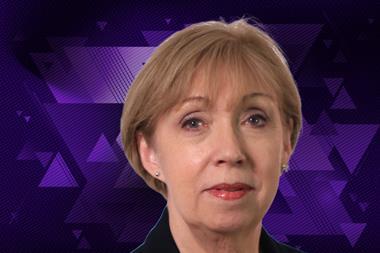30 Kate Bostock, executive director, clothing, Marks & Spencer
2007 RANK: 39
A prot駩 of fashion genius George Davies and his Next successor David Jones, Bostock is the most powerful woman in fashion. And she is now in with a chance of becoming the most powerful woman in retail if she succeeds Sir Stuart Rose as chief executive of Marks & Spencer after his retirement in 2011.
In M&S’s March reshuffle, Bostock was promoted to the retailer’s main board and her brief was extended to include all clothing – mens-, childrens- and womenswear, along with lingerie. Only Per Una, the brand founded by mentor Davies, is outside her control.
Bostock, 50, joined M&S three years ago as a key member of Rose’s turnaround team and has re-established its fashion status. She brought the perfect fashion pedigree, spanning George at Asda and Next.
There is no doubting Bostock’s retail skills, but some question whether she has the wider expertise necessary to lead M&S. She has three years in which to prove herself and become the first woman to head M&S in its 125-year existence.
31 Magnus Olsson, UK country manager, H&M
2007 RANK: N/A
H&M has proved this year why it is one of the undisputed front-runners in fast fashion. Its tie-in with Roberto Cavalli prompted scenes of chaos in its stores, with leopard-print hungry fashion hunters fighting their way to grab an Italian bargain.
Olsson’s staff tried their best to keep the stock on the shelves, but it was no mean feat. Olsson commented at the time: “I saw one of the staff come with a box of accessories to replenish the stock, but one of the shoppers saw her coming and shouted: ‘She’s got accessories’ and they swamped her. She had to just let go of the box.”
The impressive flagship store that opened on Regent Street in February also added kudos to the fashion retailer’s UK offer. H&M is now taking on the trendy and traditionally independent-led Camden area in London with Divided, a new-format store that opened last week.
32 Lord Kirkham, founder, DFS
2007 RANK: 38
Affable Yorkshireman Lord Kirkham may be the king of sofas, but even he isn’t immune to the savage downturn in the furniture market. However, with his market-leading position and the comfort of his private ownership of the business, he is in a better place than many.
Famous for his gargantuan ad spend and generous half-price offers, there is no danger of Kirkham panicking as the downturn bites. After all, the miner’s son from Doncaster has been here many times before – next year he’ll celebrate 40 years since he set up the business in his home town in 1969.
33 Nick Robertson, chief executive, Asos
2007 RANK: 72
If anyone has well and truly proved wrong the adage that fashion can’t be sold online, it is Nick Robertson.
As fashion retailers feel the sharp edge of the economic downturn, Robertson continues to produce enviable results: sales at Asos soared 88 per cent in the 42 weeks to January 20. The business that he created is the ultimate pure-play e-tail case study.
Bullish and pragmatic, Robertson exudes a great deal of energy – and he needs it. In the past year, he has not only moved head offices and kept on top of exponential growth of the business, but has also just become a father.
Robertson has also proved the reputation of his brand by attracting big hitters to his team including Karen Downie, former Topshop buying director.
With more product areas set to launch and the possibility of a flagship store in future, Robertson shows no signs of slowing down.
34 Lisa Morgan, chief executive, Game
2007 RANK: 65
Aged only 36, Morgan is doubly unusual among retail chief executives in being both young and female. She is also an avid gamer and knows all about being competitive, having topped Retail Week’s table of like-for-like Christmas sales for three years running.
Morgan likes to keep her profile low, but her company is now bigger in value terms than many better-known retailers such as Debenhams, HMV and Sports Direct.
Game has often been written off as the ultimate cyclical stock, driven by the fortunes of two or three manufacturers. However, attracting more female and older customers into the core chain, while bolting on rival Gamestation for the more hard-core gamers, has proved a successful strategy for this retail high-flier.
35 Peter Hd, mid-Europe manager, Ikea
2007 RANK: 35
The UK’s biggest furniture retailer just keeps on growing under Hd’s direction. Since the laid-back, quick-witted Dane arrived to run the UK business in 2003, the five-year,£750 million investment he has overseen has paid off.
Despite a notoriously tough furniture sector, sales for the year to August 2007 climbed 7 per cent. 2008 is proving tougher though. And his grand plans continue: he believes there is easily room for another 10 stores in the UK if only he could get planning permission.
The company has built a new flagship in-town store in Coventry, but the results haven’t matched up to its giant out-of-town boxes.
36 Alan White, chief executive, N Brown
2007 RANK: 82
The home shopping sector has been one of the surprise winners from the credit crunch and, as chief of one of the country’s leading home shopping companies, Manchester-based N Brown, Alan White has had a far smoother year than most.
The affable White has become the face of home shopping. He has taken advantage of niche fashion customers with offers for its Simply Be and Jacamo brands, which offer extensive size ranges. It is one of the very few retailers from which a woman could purchase a 56L bra. N Brown also has access to one of the fastest-growing consumer groups, the silver-surfer generation, with an average customer age of 58.
With 47 web sites and 20 mail order catalogues, systems and logistics are key and keeps the N Brown boss on his toes. He’s also assumed a further responsibility, becoming a non-executive director at Topps Tiles.
37 Mike Shearwood, deputy chief executive, Mosaic Fashions
2007 RANK: 34
Rugby fanatic Mike Shearwood has plenty of time on his train journey from Nottinghamshire to London every day to ponder how to tackle the challenging fashion market, but he’s wasted no time getting to grips with the sprawling Mosaic Fashions empire.
The optician-turned-fashion-retailer, who was the key player in the emergence of Zara in the UK, has formed a strong partnership with veteran Mosaic chief executive Derek Lovelock. While Lovelock focuses on the product side, Shearwood has been concentrating on getting the operations into shape after a fevered period of acquisitions, which left the company with a touch of corporate indigestion.
38 Mark Price, managing director, Waitrose
2007 RANK: N/A
His critics say the self-confessed “chubby grocer” could come a cropper with his penchant for honest, public speaking if he ran a listed supermarket. However, Price has far more admirers who recognise the significant changes he has made since taking the helm last year and enjoy the colour he brings to a fairly monotone supermarket scene..
Above all, Price has taken a close look at Waitrose’s pricing strategy, particularly on core branded lines. Price considered Waitrose’s reputation for being expensive unacceptable – although he concedes its customers pay a premium on luxury food.
Under his direction, the supermarket chain has also introduced two new and successful store formats in London, of which elements are being rolled out to Waitrose’s wider portfolio.
Price has other new formats up his sleeve and is thought to be considering launching a convenience format. He may end up getting fewer Somerfield stores than he originally wanted, but Price is creating a leaner grocer to fight its rivals with.
39 Ben Gordon, chief executive, Mothercare
2007 RANK: 48
Regardless of a spending downturn, the one area where shoppers are reluctant to rein in their spending is their children. So, while many retailers have reported negative like-for-like sales and profit warnings have come thick and fast, Ben Gordon and Mothercare has continued to progress in a tough market.
After the£85 million acquisition of Early Learning Centre (ELC) last year, Gordon has set about integrating the ELC brand into existing Mothercare outlets. The retailer has also been one of the few to grapple with the medium of social networking, launching its own interactive site Gurgle.com in October.
Those who had their doubts that Gordon would succeed in turning around the once-struggling retailer have been proved wrong. Despite the success at home, Gordon’s greatest triumph has been its rapid expansion. It now has 494 outlets across 48 countries and, with the new joint venture with Goodbaby in China, the business seems set for further growth.
Topics
Retail Power List 2008: 1-9
- 1
- 2
- 3
- 4
- 5
 Currently reading
Currently readingRetail Power List 2008: 30-39
- 6
- 7
- 8

































No comments yet